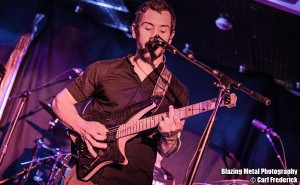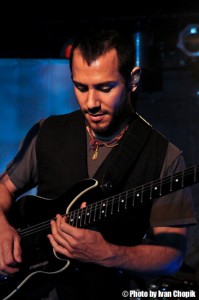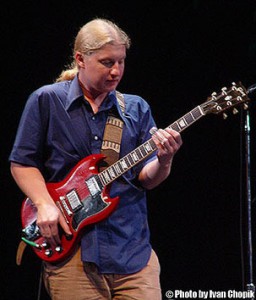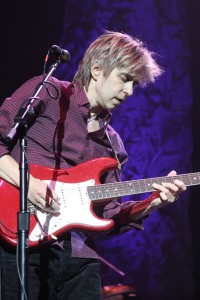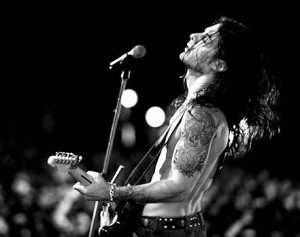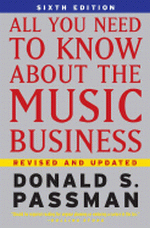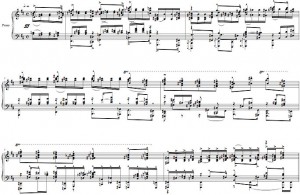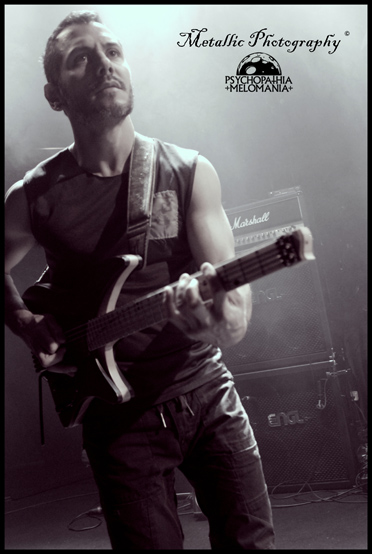 When the ‘prog’ label is invoked, does it imply a ‘progressive’ take on broader musical traditions, or rather, can it refer to an individual band’s own ‘progress’ of musical growth and exploration?
When the ‘prog’ label is invoked, does it imply a ‘progressive’ take on broader musical traditions, or rather, can it refer to an individual band’s own ‘progress’ of musical growth and exploration?
With that question in mind, I submit to you Cynic’s new album Kindly Bent to Free Us as an early front-runner for prog album the year. Extreme music fans across the globe have unanimously sung the praises of Cynic since their return with 2008’s Traced in Air, though the new album has proved to both confound and divide critics and fans alike.
While their 2011 EP Carbon-Based Anatomy teased lush soundscapes along with more worldly orchestration and percussion, the new release is unabashedly driven by Paul Masvidal’s guitar work of silk and sinew, Sean Malone’s unrelenting fretless bass riffs, and Sean Reinert’s deft drum work. Gone are the vocoder-drenched vocals that helped Cynic establish its unique voice amidst the Florida metal scene of the early ’90s. The psychedelic studio flourishes that helped redefine the band’s 21st century return have largely sobered up.
What remains is the very core of what kept the heart of Cynic’s music beating even through their fourteen year hibernation: fusion riffs flayed over equal parts jazz and metal rhythms and soaring vocal melodies. Denied the studio sleight of hand and removed from the present day, KBtFU sounds like an anachronism; a classic ’80s thrash album abducted and anointed by some cosmic intelligence. To its detractors it may sound like regression, but to any long-time fans that have followed Cynic into space over the years, they know that the most daring place the band could go would be down to earth.
Guitar Messenger’s Luke Dennis recently had the opportunity to speak with Paul Masvidal, Cynic’s guitarist, vocalist, and chief composer. Over the course of this four part interview series, Paul opened up about the new album, his compositional process, why he doesn’t want to do Cynic full time, and his life and projects outside of Cynic:
Part II | Part III | Part IV
NEW ALBUM: Kindly Bent to Free Us
LD: When we last talked, you alluded to how Carbon-Based Anatomy came from a very dark place and how difficult a time it was for you and Sean [Reinert, drummer]. Can you set the stage for where you were coming from when you went into the studio to record Kindly Bent to Free Us?
PM: This is a record that we’ve been working on and off since post-Traced in Air. It’s something that was in the background when Carbon-Based Anatomy happened, even Re-Traced to a certain degree, so joining up in the studio was part of a bigger process. We knew that the drums and the basic arrangements were there in terms of having been fleshed during pre-productions. We went in last year, cut drums and some basic guitar stuff before we took off on the [Chuck Schuldiner tribute] Death To All tour. Then we finally had to come home and get back to it. The headspace was really just an accumulation of a lot of time to let this material gestate and see what happens in terms of our own lives.
I think with C-BA, the layering and the wall-of-sound ambience on that record was really about the headspace. It was kind of a mirror of where we were: murky, cloudy, kind of pissed. [laughs] There was a lot of stuff going on there. It’s one of those records that’s really dense in terms of the headphone experience. There were some songs that had twenty, thirty guitar tracks. It’s very subtle and hard to hear, but they’re in there.
I think that was more of a reflection of where we were psychologically at the time and now Kindly Bent to Free Us is stepping into something more vulnerable in a sense; not hiding behind the layered ambiance. It’s always easier to pack things in and hide behind them. We’ve been very good at that in various ways.
I feel like this record is definitely the biggest unpeeling of the onion in terms of honesty and transparency, trying to be naked, not only lyrically, but also musically. It’s a trio album. There’s not a lot of guitar layering. It’s pretty much just two guitars, double tracked. I went for this one pretty straight: one main dirty tone and one main clean tone, which is the opposite of how I’ve approached every other Cynic record. I did that on purpose, because I just wanted to see how this stuff held up without all of the icing and the decorative elements that I tend to get carried away with.
What I found was that everything seemed to count more. It’s the most it’s ever felt like a band, in terms of this interactive trio kind of thing, without getting so caught up in the studio. And then, of course, I got to layering with the vocals, keyboards, and whatnot. [laughs] Definitely in a much minor way, less than what happened on C-BA. This album just feels like stepping into our skin a bit more and having the courage to be a bit more honest about what we’re doing as artists. It’s just another step in Cynic’s sonic experience and it feels good. I’m happy about it.
LD: On the performance side of making such a stripped-down record, were you guys enjoying playing together more as a band?
PM: Yeah, definitely, especially with the rhythm section, I think Sean and [bassist Sean] Malone really got to stretch out, because Sean has a tendency to play a lot. He’s a busy drummer, but on this stuff he really just wanted to lay it down, which opened things up for Malone and me to not have to counter constant parts that are competing with each other. It just created a lot of space. Everyone seemed to have a voice on this record in a way that we’ve never had it before – independent, but completely cohesive and melding.
It has an old school kind of approach. It’s raw and imperfect and I like that. In the past we’ve gone to special lengths to get so neurotic about production stuff and I feel like this record has a certain crudeness to it, which I’m digging. It gives them a sense of urgency and authenticity. We were very much all about trying to engage and be a trio, letting ourselves be liberated without getting too caught up in what we thought about the arrangement. That’s why there are a lot of extended sections on this album. Cynic always edited that down and on this record we just went for it. We were like, ‘Let’s just play this riff out for a minute or two and see what happens.’ All those kinds of things were definitely more band-like than ever before.
LD: One thing that really stuck in my mind from our last conversation is how you likened the process of making music to ‘sculpting’ sound. Given the less production-driven nature of the new album, did it feel like you were working with a different raw material by putting so much more focus on just playing your instruments?
PM: Well, no. Every Cynic song starts on an acoustic guitar or a piano. The demos that I make before Sean or Malone even hear them, are just basically guitar and voice. They’re like these little prog-folk songs. I go to great lengths to realize those arrangements, before I even give them to the guys. These tunes always start with a really strong harmonic base and melodic foundation that can be taken anywhere. Once you have that, the sculpting part I think happens in the production side, when you start figuring out how this is going to be represented as an album.
The origins are really stark and minimal. That’s really how all these songs start. I’ve gone through some phases where I’ve composed using technology, where it’s a sound that inspires you and suddenly you’re led down a certain path. But for me, I found I’m definitely more of an old school guy. I want to be able to just play these tunes on acoustic guitar and sing and just hold them that way. It makes them intimate. A lot of times I start with just finger-picking on the acoustic as I figure out how to define it as a rock song. Sometimes the whole feel will change based on converting it to an electric and then figuring out what the grooves are. That’s really where the other guys first come in.
| Cynic – True Hallucination Speak (Official Lyric Video) |
This whole process is extremely organic. As I see it, if you have a strong foundation, a tune that can hold up without all the extras and stuff, you can go anywhere. You have so much freedom at that point to produce it any way you like. You almost can’t do wrong, because at the root of this is a really strong melody and some good chord changes.
I see it like a jazz standard or something: you want it to work in a timeless kind of way as a song and then figure out what the hell it means to the production later. At the end of the day, everyone is trying to hum, bang or feel something, really trying to connect with another person. That’s the essence that you want to retain. I’m always trying to hold on to that pure kind of root when it turns into a production, which is a very delicate process, because it’s easy to get carried away in the studio and lose sight of what you originally intended.
I have a good friend who immediately records and produces songs as he writes them. If he has a little demo, he goes and cuts it immediately as the final version. It’s his way of keeping it in that pure first state, keeping the freshness of it. A lot of times if you accumulate stuff, you’re in a different place a few months down the road, and all of a sudden you hear that thing differently and you want to change it. I thought that was really interesting that he just wants to document it as it is, right when he feels it, and then move on. It’s a really cool way of making art, because it keeps you moving instead of coming back, mulling over it and getting neurotic about stuff, which I have a tendency to do, as well.
LD: How far away from those original acoustic demos do you feel like the songs have come?
PM: I feel like musically they’ve retained their shape, though a lot of the lyrics changed over time. There are certain songs on the record like ‘Moon Heart Sun Head’ that we just started gutting. There was that root kind of verse/chorus stuff, and then some new other extended sections that I had. But then in the studio it became this weird arrangement and it just shifted into this whole other thing and I went with it. Certain songs definitely went into different places, but they still all managed to retain their core – that essence which is really the most important thing for me.
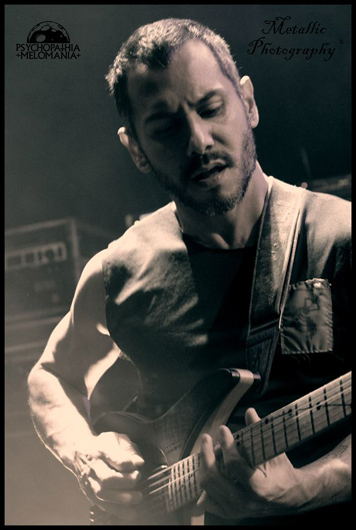
Some are ridiculously close to the demo. I think about a song like ‘Infinite Shapes,’ and everything from the demo is right there. But I remember when we went to record it and I was playing around with the guitar parts. I had this weird arpeggiated swirly thing for the verses where the chords were being plucked, and then they were just expanding. It was really psychedelic and I was getting carried away. Then I remember Malone pulling me back and just going, ‘Don’t! Come back to those simple chord changes that you were just playing on the demo and let it just sit!’
I remember that was one of those moments where we took the leap, trusting in the nakedness. That verse of that song is so bare. I think it’s the most bare-bones we’ve ever been. At the same time, it’s so cool because when the chorus hits, it’s packed. It’s got a wall of vocals and these really big guitar chords that are going across all six strings. There was a nice contrast I didn’t even see and it took Malone to call that out and be like, ‘There’s a lot of density here. You don’t need it everywhere.’
I don’t really know what a record is going to sound like until we start making it. We can talk about it for days, but when you get down to doing, it just does itself and tells you as you go. I think it became clear to us with the demos that the more we started getting into this material, the more I realized I didn’t want to clutter it. It’s so easy for me to add a second guitar part or pack environments with layers. I just thought, ‘This is going to be all about reduction.’ It just felt more and more like it needed to do that. It was like stepping out of a cocoon and forcing me to grow in ways that I normally wouldn’t. It pushed me out of my safety zones.
LD: Are you guys planning a tour for this album?
PM: We’re planning on it. We haven’t been as aggressive this time around, just because I think for us, we’re working musicians and we don’t want to just tour to tour. We want to do it right. Right now the plan is these shorter little runs. I think there’s going to be a California or a west coast run happening, from Vancouver all the way down to San Diego. Then we’re doing this festival opening for Metallica in Montreal and we might turn that into a northeast run leading to that show.
There are little things like that, but a big tour hasn’t hit us. We’ve had a few support opportunities appear, but we’re just hesitant. We’re taking it one moment at a time and seeing what unfolds. I’m sure there will be some touring and opportunities for us to be seen, but we’re not in the biggest hurry to run out there. I think we just want to do it right. We’ve done a lot of touring over the years and we’re just trying to mix it up.
Part II
In the second part of our interview, Paul takes us inside his current guitar set up. Check it out HERE.
[Special thanks to Metallic @ Psychopathia Melomania for allowing us to use a few of his outstanding live photos of Paul Masvidal].





